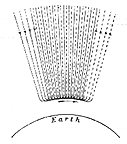|
The drawing at left shows narrow sections of these sheets on the morning and evening side, viewed from midnight, with the current closing around midnight as drawn; only narrow sections are shown, because one cannot draw the full sheets without having them obscure each other.
As Fukushima had foreseen, that circuit had only a small effect on magnetometers on the ground.Instead, the disturbances measured at the surface of the Earth come mainly from the electrojets, which are a by-product of the main circuit due to the unusual electric conductivity properties of the ionosphere. It is possible that they indeed close largely in the ionosphere.
Although signs of currents flowing from space along magnetic field lines were occasionally detected by earlier satellites, it was the US Navy's Triad,
carrying the instrument of Alfred Zmuda and James Armstrong, that in 1973 traced their full pattern. Triad was an experimental navigation satellite, and it circled the Earth in a low altitude orbit which went from pole to pole, while the Earth rotated beneath it. Zmuda and Armstrong were allowed to place on it a magnetometer as an extra "piggyback experiment," and it continued to return scientific data for many years after the Navy's experiment had ended.
When Triad crossed a current sheet, a characteristic "signature" was
generally noted: the direction of the magnetic field rotated fairly abruptly, while its strength stayed practically the same. From such rotations a wealth of information was extracted about the structure and variation of the currents. Tragically, both experimenters had died by the time their article on "Birkeland currents" appeared in 1974.
|


 Official GSFC Home Page
Official GSFC Home Page  NASA WWW Home Page
NASA WWW Home Page